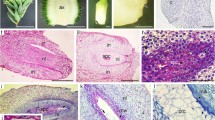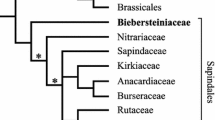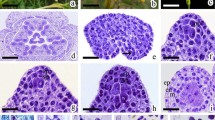Summary
The embryology ofAlangium Lamarckii Thw. has been studied. A cross-section of the anther shows an epidermis, the endothecium, a single middle layer and the tapetum. The haploid number of chromosomes is eight. There is a single anatropous ovule with one integument. The development of the embryo-sac conforms to the Normal type and an epithelial layer is formed from the inner epidermis of the integument. Fertilization is porogamous and the endosperm nuclear. It is concluded that the genusAlangium should be placed in a separate family, the Alangiaceæ, under the order Umbellifloræ.
Similar content being viewed by others
References
Bentham and HookerFlora of British India, 1879.
Cooper, D. C. “Nuclear divisions in the tapetal cells of certain Angiosperms,”Amer. Jour. Bot., 1933,20, 358–64.
Coulter, J. M., and Chamberlain, C. J.Morphology of Angiosperms, Univ. Chicago Press, 1903.
Ducamp, L. “Recherches sur l’embryogénie des Araliacées,”Ann. Sc. Nat. Bot., 1907, Sér.8, 15, 331–402.
Engler, A., and Prantl, P.Die Natürlichen Pflazenfamilien, 1931.
Gopinath, D. M. “Cases of Antipodal polyembryony inAlangium Lamarckii Thw.,”Curr. Sci., 1943,12, 329–30.
— “Gametogenesis and Embryogeny in a few members of the Araliaceæ,”Proc. Ind. Acad. Sci., 1944,20, No. 5, B, 175–86.
Horne, A. S. “A contribution to the study of evolution of the flower, with special reference to the Hamamelidaceæ, Caprifoliaceæ and Cornaceæ,”Trans. Linn. Soc. London, 1914,8, 239–309.
Häkansson, A. “Studien über die Entwicklungs geschichte der Umbelliferen,”Lunds Univ. Arsska. N.F., 1923, Afd.2, 18, Nr. 7.
Hutchinson,J. Families of Flowering Plants, I,Dicotyledons, London, 1926.
Jönsson, B. “Ytterligare bidrag till Kānnedomen Angiospermernas Embryo-Sac,”Kutveckling. Bot. Not., 1881, 169–187.
Jöshi, A. C., and Venkateswarlu, J. “Embryological studies in the Lythraceæ: II.Lagerstrœmia Linn.,”Proc. Ind. Acad. Sci., B, 1935’36,2, 523–34.
Morse, W. C. “Contribution to the life-history ofCornus florida,”Ohio Nat., 1907,8, 197–204.
Palm, B., and Rutgers, A. A. L. “Embryology ofAcuba Japonica”Rec. Trav. Bot. Néerl., 1917,14, 119–26.
Schnarf, K. “ Beitrage zur Kenntnis des Blüten baues von Alangium,”Sitzb. Akad. Wien. math. Nat., 1922, Kl. 131, Abt. I, 199–208.
-Vergleichende Embryologie der Angiospermen, Gebrüder Borntræger, Berlin, 1931.
Wangerin, W. “Alangiaceæ” inEngler’s Das Pflanzenreich, 1910,4, 220b.
Author information
Authors and Affiliations
Additional information
Communicated by Prof. L. S. S. Kumar,f.a.sc.
Rights and permissions
About this article
Cite this article
Gopinath, D.M. A Contribution to the embryology ofAlangium Lamarckii Thw. with a discussion of the systematic position of the family alangiaceæ. Proc. Indian Acad. Sci. 22, 225–231 (1945). https://doi.org/10.1007/BF03049876
Received:
Issue Date:
DOI: https://doi.org/10.1007/BF03049876




